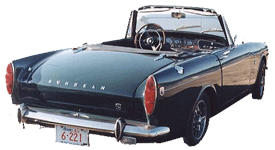The Restoration of PRRROWL
TIGER # B382000221

An Article by John Crawley
March, 2001
Page 24
INSTRUMENTS
Speedo Servicing
Your speedo needs servicing. You may save yourself a very expensive speedo repair by having it serviced. If your instrument has been operating for years and has never broken down it may be on the edge of self-destruction. You can do the service yourself but for most people it is best to take it to a repair shop. The main places that need service are the bushing areas. There are three of them. The main bushing is the area that the cable enters the speedo head. This needs some lubrication. Place the speedo face down and fill the hole where the cable enters to almost over flowing with clock oil. Do not let excess run into speedo head. Run the speedo with an electric drill for a minute to allow some lube to work its way into the bushing and then carefully empty out any excess oil.
The next places are even more important but they do require taking the head apart. I have done this but care must be exercised. If in doubt take it to a repair shop. If not proceed at your own risk — !!!
Remove: Bezel, glass, insert ring, needle and face plate. Remove trip-meter-reset -spindle by pressing out the tiny roll pin. Remove two screws from back of speedo body. The speedo works can now be removed from the speedo body.
When you examine the works you will see that there are two fiber gears that run on the brass worm gear attached to the end of the main drive were the cable enters. The bushings of these worm gears are the area that must be serviced. The gears and shafts that they are mounted on are held in with small oval shaped keeper springs. These keepers have slots in them and may be removed by lifting on one end and sliding forward. The gears are then easily pressed out. The service is simple: clean off the shaft, clean out the bearing with a roll of fine wet and dry emery, lube the surfaces and put it back together. These shafts drive eccentrics that move ratchets that turn the trip gauges and the mileage total. Be careful to observe were the springs attach to these ratchets as they may come loose when the keepers are removed. Resemble is in the reverse as the books so often say.
Tip: Service your speedo before it self-destructs. A replacement TIGER speedo is hard to find. If your TIGER speedo needs work find a working Alpine speedo. Many of the parts will fit the TIGER’s and Alpine speedometers are much easier to find.
Temp Gauge
Author's Note: Read other postings on adjusting Temperature Gauges. This is only what I did and it worked for me.
Editor's Note: The typical DC power supply available at electronic stores, although labeled with a DC voltage, is not an accurate value. The actual voltage varies with the load placed on it, and these are intended for devices that are not to sensitive to exact levels. This is NOT the case with your Temperature sender/gauge, or your fuel level system. The Tiger has a voltage regulator, contained in a small rectangular can, that is supposed to condition your battery voltage to the required 10 volt input. There are varying opinions on this Lucas design, and both Theo Smit and Cullen Bennett have designed small solid-state precision regulators for obtaining maximum accuracy. If you are using a Radio Shack "brick", be sure to use an accurate voltmeter to determine that the supplied voltage is exactly 10 volts D.C. before you try to calibrate these instruments. Even removing the Tiger regulator (in small can behind dash) and powering it with your car battery would be much more accurate. Again, even measure the output voltage, with instruments and senders in the circuit, to assure that the car's regulator is accurate (don't hold your breath). Some digital volt-ohm metera are not expensive, and can give good enough accuracy. Do not attempt these techniques unless you have experience with devices of this nature, A car battery short can cause a fire, or burn-out your gauge.
To test your Temperature sender & gauge and 10 volt power supply try the following:
Remove sender from intake manifold and extend the sender wire with some temporary jumper wires from the engine compartment to a source of boiling water such as an electric kettle. Remember to run a ground wire. Drop the end of the sender in the water after you have hooked it up to the jumper wires.
Remove the gauge form the dash. Extent the under-dash wire connections to the gauge.
Turn on the ignition key. The needle should stop at exactly 100 Deg. C. If you find that your Tiger's Temperature gauge is not accurate you can try to adjust it your self. On the back of the gauge there are two pins with slotted screw nuts on them. Loosen these just a bit. Next pry out the cork plug from the hole beside the right hand pin. Under this plug you will find a slotted plate that will take a small screwdriver. You adjust this plate, just like you do ignition points, by swinging the plate left and right. Set the needle to read correctly, lock the slotted screw, replace the plug and reinstall the gauge and sender. You should have a perfectly adjusted temperature gauge for your car for your altitude.
 **
**
